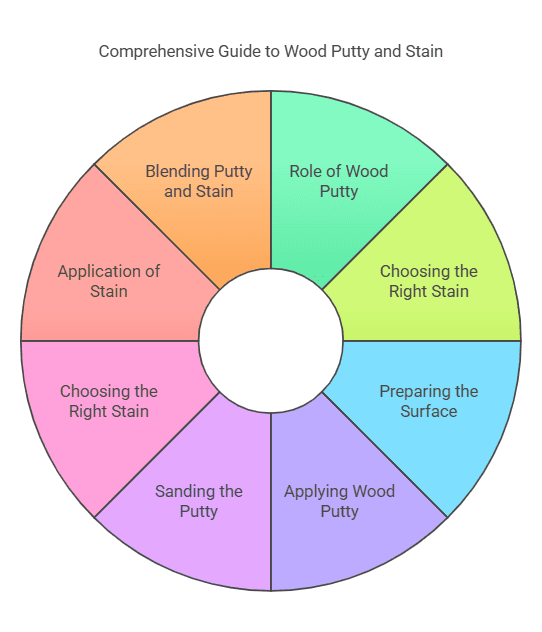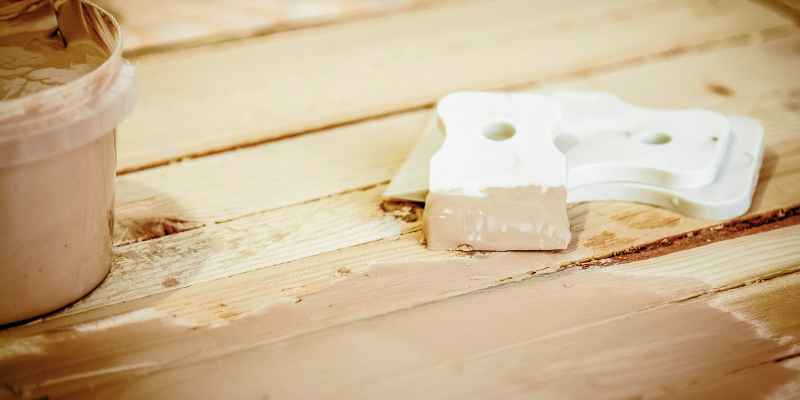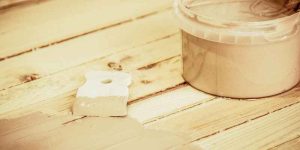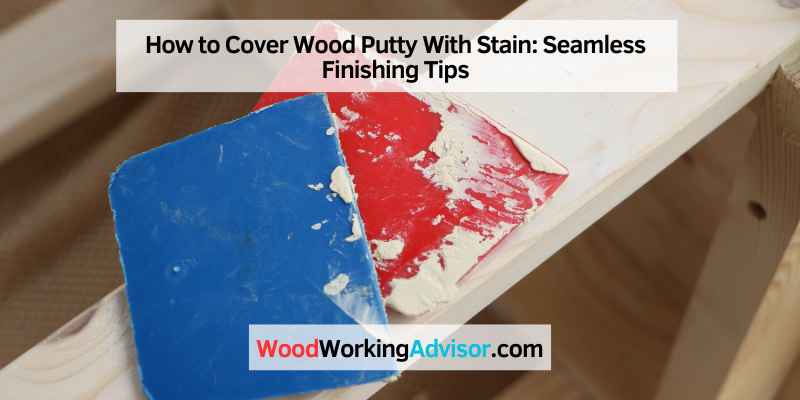To cover wood putty with stain, apply the stain evenly over the putty and surrounding wood. Use a brush for best results.
Covering wood putty with stain is a crucial step in woodworking projects. It helps blend the putty seamlessly with the wood, creating a cohesive finish. By following the correct technique, you can achieve a flawless result that enhances the overall look of your project.
We will explore the process of covering wood putty with stain in a simple and effective manner. Whether you are a beginner or an experienced woodworker, mastering this skill will elevate the quality of your craftsmanship. Let’s delve into the details of how to seamlessly cover wood putty with stain for professional-looking results.
Introduction To Wood Putty And Stain
Wood putty and stain are essential elements in woodworking projects. Wood putty, also known as wood filler, is a handy substance used to fill in gaps, cracks, or holes in wooden surfaces. It helps create a smooth and seamless appearance, ensuring that the wood looks flawless.
The Role Of Wood Putty In Woodworking
Wood putty plays a crucial role in woodworking as it allows for the repair and restoration of damaged or imperfect wooden surfaces. Whether you are working on furniture, cabinetry, or any other wooden project, wood putty can help you achieve a polished and professional finish.
Here are some key benefits and uses of wood putty:
- Repairing cracks and holes: Wood putty is perfect for filling in cracks, holes, and other imperfections in wooden surfaces.
- Smoothing out rough areas: It helps smooth out rough patches and uneven surfaces, providing a seamless finish.
- Enhancing the appearance: Wood putty can be used to enhance the overall appearance of the wood by hiding blemishes and creating a uniform look.
- Preventing moisture damage: By filling gaps and cracks, wood putty helps prevent moisture from seeping into the wood, reducing the risk of damage.
Choosing The Right Stain For Your Project
When it comes to adding color and protection to your woodwork, stain is an excellent choice. However, selecting the right stain for your project is crucial to achieve the desired results. Here are a few factors to consider:
- Wood type: Different wood species absorb stain differently, so it’s essential to choose a stain that works well with the specific wood you are using.
- Color preference: Stains come in various shades and tones, allowing you to choose a color that complements your overall design aesthetic.
- Transparency level: Stains can be transparent, semi-transparent, or opaque. Consider the level of transparency you desire to showcase the wood grain or achieve a solid color.
- Finish: Stains offer different finishes, such as matte, satin, or glossy. Select a finish that matches your desired look and provides the right level of protection.
By carefully considering these factors, you can select the ideal stain that will enhance the natural beauty of the wood and bring your project to life.

Preparing The Surface
When it comes to achieving a flawless wood finish, proper preparation is key. Before covering wood putty with stain, it’s important to ensure the surface is clean and smooth to achieve the best results. This involves cleaning the wood, sanding for a smooth base, and ensuring the putty is properly applied.
Cleaning The Wood
Begin by thoroughly cleaning the wood surface to remove any dust, dirt, or debris. Use a damp cloth to wipe down the area, ensuring all residues are removed. This will provide a clean base for the putty and stain application.
Sanding For A Smooth Base
After cleaning, sand the wood surface to create a smooth and even base for the wood putty. Start with a coarse-grit sandpaper to remove any rough spots or imperfections. Then, switch to a finer-grit sandpaper for a smoother finish. Be sure to sand in the direction of the wood grain to prevent any damage to the surface.
Applying Wood Putty
Applying wood putty is an essential step in achieving a smooth and flawless finish when staining wood surfaces. Proper application of wood putty ensures that any imperfections, cracks, or gaps are seamlessly filled, resulting in a professional-looking final product. In this section, we will explore the process of selecting the correct putty color and various techniques for effectively filling gaps with wood putty.
Selecting The Correct Putty Color
Choosing the right putty color is crucial for achieving a seamless blend with the surrounding wood. Examine the wood carefully to identify its natural color and undertones. Select a putty color that closely matches the wood’s hue, ensuring a cohesive and natural-looking result.
Techniques For Filling Gaps
- Prepare the wood surface by cleaning away any debris and ensuring it is smooth and dry.
- Take a small amount of wood putty and press it into the gap using a putty knife or a similar tool.
- Smooth the putty along the gap, ensuring it is level with the surface of the wood.
- Wipe away any excess putty using a clean, damp cloth to achieve a neat finish.
- Allow the putty to dry completely before proceeding with the staining process.
Sanding The Putty
Once you have filled the wood defects with putty, the next step is to sand it down for a smooth and seamless finish. Sanding is crucial in achieving a flush surface that seamlessly blends with the surrounding wood. Here are some tips to help you efficiently sand the putty.
Achieving A Flush Surface
When sanding the putty, the goal is to create a flush surface that is level with the rest of the wood. This ensures that the stain will be evenly applied and the repaired area will seamlessly blend in.
To achieve a flush surface:
- Start with a coarse grit sandpaper, such as 80 or 100 grit, to quickly remove excess putty and level the surface.
- Sand in the direction of the wood grain to prevent any scratches or damage to the surrounding wood.
- Regularly check the surface with your hand to feel for any unevenness. Smooth out any high spots or ridges by continuing to sand.
- As you approach a flush surface, switch to a finer grit sandpaper, such as 150 or 180 grit, for a smoother finish.
- Continue sanding with progressively finer grits until the putty is completely blended with the wood.
Tips For Efficient Sanding
To make the sanding process more efficient and effective, consider the following tips:
- Use a sanding block or sanding sponge to maintain a consistent pressure and avoid creating dips or uneven areas.
- Change the sandpaper regularly to ensure optimal performance. A worn-out sandpaper will be less effective in smoothing the putty.
- Keep the sandpaper clean by periodically tapping it against a hard surface or using a sandpaper cleaning tool. This prevents clogging and extends the life of the sandpaper.
- Work in small sections at a time, focusing on one area before moving on to the next. This allows you to have better control over the sanding process.
- Wipe away any dust or debris between sanding grits to ensure a clean surface for the next sanding step.
By following these guidelines, you can achieve a smooth and seamless finish when covering wood putty with stain. Sanding the putty properly is a crucial step in the overall process, as it sets the foundation for a flawless end result.

Choosing The Right Stain
Matching Stain To Putty
When it comes to covering wood putty with stain, selecting the right stain is crucial. The chosen stain should complement the wood putty and blend seamlessly with the surrounding wood. To ensure a cohesive finish, it’s important to match the stain to the putty color.
Types Of Stains And Their Benefits
Two common types of stains are oil-based and water-based. Oil-based stains offer deep penetration and rich color, while water-based stains dry faster and emit fewer odors. Both types provide protection and enhance the natural beauty of the wood.
Application Of Stain
Tools For Applying Stain
- Brushes: Choose a high-quality brush for precise application.
- Rags: Clean, lint-free cloths are great for wiping excess stain.
- Sponge: Ideal for a smooth and even application on large surfaces.
Methods For Even Stain Coverage
- Stir the stain thoroughly before applying.
- Apply in the direction of the wood grain for uniform finish.
- Wipe off excess stain with a rag to prevent blotching.
- Allow each coat to dry completely before adding another layer.
Blending Putty And Stain
When it comes to achieving a seamless finish on wood surfaces, blending putty with stain is essential. By following the right techniques, you can ensure that the wood putty blends in perfectly with the rest of the wood, creating a cohesive look.
Techniques For Seamless Integration
One effective technique is to mix the wood putty with a small amount of stain before applying it to the surface. This helps the putty absorb the color of the stain, making it less noticeable.
Troubleshooting Common Issues
If the putty appears too light after staining, you can darken it by applying additional layers of stain until you achieve the desired color match.
Finishing Touches
When it comes to completing your woodworking project, the finishing touches are crucial in achieving a professional look. Here’s how to apply a top coat and maintain your finished project:
Applying A Top Coat
- Choose a clear top coat to protect the stained wood.
- Apply the top coat evenly with a brush or cloth.
- Let the top coat dry completely before using the furniture.
Maintenance And Care For Your Finished Project
- Regularly dust the furniture to keep it clean.
- Avoid placing hot items directly on the surface.
- Use coasters or placemats to prevent water damage.

Frequently Asked Questions
How Do You Cover Wood Putty With Stain?
To cover wood putty with stain, first, sand the putty area until it’s smooth. Then, apply the stain to the entire wood surface, including the putty area. Finally, wipe off any excess stain with a clean cloth and let it dry completely.
Can You Stain Over Wood Filler?
Yes, you can stain over wood filler. After the wood filler dries, sand the area until it’s smooth. Then, apply the stain to the entire surface, including the wood filler area. Finally, wipe off any excess stain with a clean cloth and let it dry completely.
What Is The Difference Between Wood Putty And Wood Filler?
Wood putty is a thicker consistency and is used for filling small holes and gaps in wood. Wood filler is a thinner consistency and is used for filling larger holes and gaps in wood. Wood filler is also more durable and can be sanded and stained like real wood.
How Long Does Wood Putty Take To Dry?
The drying time of wood putty depends on the thickness of the application and the temperature and humidity of the environment. Generally, it takes around 1-3 hours to dry completely. It’s best to wait at least 24 hours before sanding or staining the wood putty area.
Conclusion
Covering wood putty with stain is a simple yet important step in achieving a flawless finish. It requires careful preparation, including sanding and cleaning the surface, and selecting the right type of stain. Following these steps will ensure that the wood putty blends seamlessly with the surrounding wood, creating a cohesive look.
By using these tips and techniques, you can achieve a professional-quality finish that will enhance the beauty and longevity of your woodwork.

